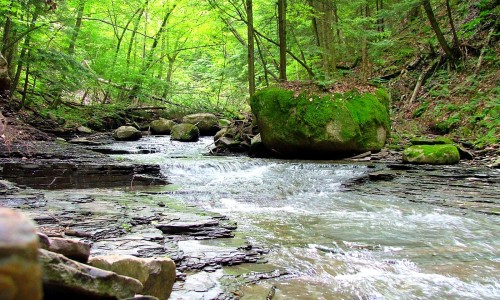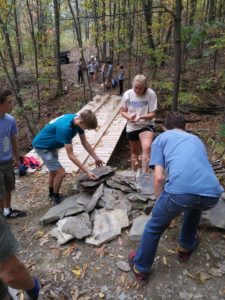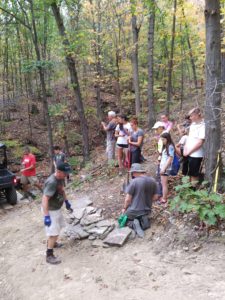On Saturday, Oct 14, 2017, Linda and I attended the annual Finger Lakes Trail Conference’s Trail Maintenance Meeting in Bath NY. This meeting is set up for the many hikers who have volunteered to maintain a section of the 1000 miles of the Finger Lakes Trail system. As we all introduced ourselves, I was struck by the number of couples who have volunteered to maintain about 6 miles of trail. If you enjoy the trails, please check out the opportunities for volunteering.
Springwater Trails has committed to maintaining the section of the Bristol Hills Trail from Clement Rd (Access 3) to the town of Naples (Access 5). Our work has included cleanup, mowing and weed wacking, and blazing. Our most recent project involved rerouting a section of the trail to take advantage of a new bridge built by the landowner across a gully.
Back to the Saturday meeting, I would like to share a small part of the information provided. It was a good meeting, a chance to meet other volunteers and to communicate with the FLTC organization. The meeting was led by the VP of Trail Quality, Lynda Rummel.
The morning was devoted to how the FLTC works with the 800 private landowners that host nearly half of the trail. Clearly, these landowners are the backbone of the trail and without their support, the trail would only be a disjointed collection of state forest and park trails. Whenever you meet a landowner, please thank them for allowing you and other hikers to enjoy their land. And when you are hiking, always respect the rights of the landowners and their property.
There are three types of agreements between the FLTC and landowners. Most of the trail is built based on Handshake agreements.Generally the FLTC will confirm a handshake agreement by letter, but on-going use of the trail is not legally guaranteed. A more formal agreement consists of a Trail Use Agreement which is signed by both the FLTC and the Landowner and provides general stipulations about the trail. It is a good vehicle for outlining permitted usages, special blazing and other requirements. Finally, a Trail Easement is a legal agreement recorded with the property deed at the county clerk’s office. The Trail Easement grants permission for the Finger Lakes Trails to pass through a defined corridor of the landowner’s property. This is a permanent easement that stays with the property, passing on to subsequent owners.
Dave Newman, VP of Trail Preservation, provided us with several examples of FLTC work to maintain these trail agreements.Trail maintainers can help by keeping in touch with landowners, and when appropriate, discussing a permanent Trail Easement with them. The FLTC will then work with the landowner to document the Easement and file it with the county clerk – there is no cost to the landowner. Dave shared three case studies including the Bristol Hills Branch section from High Tor to Italy Valley where the decision of one landowner to revoke permission for the trail required the addition of a couple of miles of road walk to the trail. A more positive example occurred south of Ithaca when the Finger Lakes Land Trust contacted the FLTC about land that was available for purchase for conservation purposes. Access to this property will allow the trail to move off of roads in this critical area, so the FLTC made a loan to the land trust, allowing the FLLT to purchase the land. The FLLT also is working with the New York State DEC who has expressed an interest in adding the property to the adjacent State Forest. A second piece of property was purchased directly by the FLTC, with plans to sell the portion with a house and barn, and to also transfer the rest of the property to the State Forest. This is an example of looking for creative ways to preserve properties critical to the trail.
After lunch, Peter Wybron (Regional Trail Coordinator for Genesee West), and Lynda Rummel demonstrated a gas powered wheelbarrow and a DR Mower. This equipment, and other trail maintenance equipment, are owned by the FLTC and are available to trail maintainers. Contact your Trail Coordinator for more information.
Finally we discussed big projects being planned by the FLTC including major trail building across the new property south of Ithaca, and techniques and strategies for blazing. I want to mention two items:
- Blazes should be 2″ x 6″ and painted at eye level. The lines and corners should be sharp, so the blaze is distinguishable from natural colorations including fall leaves. I saw examples on Sunday of red leaves that I saw while looking for blazes to verify the trail. Experienced blazers use a 1 inch brush because larger brushes create blazes that are too large and less crisp.
- Painting too many blazes results in color pollution in what should be a natural environment. However, too few blazes may mean that hikers wander off the trail, encroaching on landowner’s rights and causing confusion for hikers. Clearly the happy medium depends on the specific trail condition, but in general a hiker should always be able to see a blaze ahead, and in confusing locations, an extra “confidence” blaze is definitely appropriate. For example, an extra blaze after a sharp corner will reassure hikers that they have made the correct turn.
More information is available on the FLTC website. Check out the FLTC Field Maintenance Manual and back issues of the Trail Tenders’ News for as much great information as you could ask for.
 In partnership with Parks & Trails New York, New York State announced that registration is open for the tenth annual I Love My Park Day, which will be held May 1-2 at 120 state Parks, historic sites, and other public lands across New York. Press release
In partnership with Parks & Trails New York, New York State announced that registration is open for the tenth annual I Love My Park Day, which will be held May 1-2 at 120 state Parks, historic sites, and other public lands across New York. Press release



